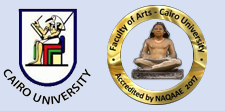عنوان المقال عربي
النمذجة الإحصائية للتنبؤ بالخصائص الهيدرولوجية للأحواض الفرعية لوادي الأردن المتصدع الشمالي
Disciplines
Physical and Environmental Geography
Document Type
Original Study
Keywords English
Jordan Rift Valley. hydrological variable, morphometric variable. Regression coefficient, Pearson's correlation, Statistical models
كلمات مفتاحية عربي
وادي الأردن الصدعي, متغير هيدرولوجي, متغير مورفومتري. معامل الانحدار, معامل ارتباط بيرسون, النماذج الإحصائية
Abstract English
Morphometric parameters are an applicable method to understand the hydrological system of water drainage basins. To determine the capabilities of sub-basins, morphometric analysis was adopted, using the linear, areal, drainage network, formality, and relief variables of the drainage basin. Moreover, remote sensing and GIS have been proven to be efficient tools for identifying morphological parameters. The morphological parameters were calculated from the digital elevation model (DEM) file with a 30 m resolution obtained from U.S. Geological Survey (USGS). Also, using algorithms formulas, represented by the SCS method for runoff estimation, equations for morphometric variables, and equations for hydrological variables estimation. A correlation matrix (Pearson's correlation coefficient) was set up between the hydrological and morphometric variables to determine that the morphometric variables had a statistically significant relationship with the hydrological variables. This would enable us to predict the hydrological variables of the sub-basins of the study area, based on linear regression analysis using SPSS. The results of the study indicate that the creation of statistical models has the ability to predict the hydrologic variables, which are runoff, lag time, concentration time, drainage time, the velocity of runoff, and flood factor. Based on morphometric variables, they were thirty-one. This is illustrated by the related equations and graphs and their applicability to drainage basins in other regions. The study might help to take water conservation measures and undertake repairs of drainage basin management structures for better decision-making in the future.
الملخص العربي
يعد تحليل المتغيرات المورفومترية طريقة قابلة للتطبيق لفهم النظام الهيدرولوجي في احواض التصريف المائي. حيث يتم الاعتماد على التحليل المورفومتري لتحديد إمكانيات الأحواض المائية الفرعية من خلال تحديد المتغيرات الخطية ، الشكلية ، خصائص الشبكة المائية ، والمتغيرات التضاريسية لاحواض التصريف المائي. علاوة على ذلك ، تعتبر تقنيات الاستشعار عن بعد و نظم المعلومات الجغرافية أدوات فعالة في تحديد المتغيرات المورفومترية، من خلال الاعتماد على نموذج الارتفاع الرقمي (DEM)، والتي تم الحصول عليها هيئة المسح الجيولوجي الأمريكية (USGS) . كما تم استخدام المعادلات الرياضية لتقدير الجريان المائي، وحساب المتغيرات المورفومترية، و حساب الخصائص الهيدرولوجية. أيضا استخدم معامل ارتباط بيرسون لاستخراج العلاقة ما بين المتغيرات المورفومترية والخصائص الهيدرولوجية في الأحواض المائية في منطقة الدراسة. كما اعتمدت الدراسة على التحليل باستخدم معادلة الانحدار الخطي بغية إنشاء نماذج إحصائية تمكننا من التنبؤ بالمتغيرات الهيدرولوجية المتمثلة بالجريان السطحي، زمن التأخير، زمن التركيز، زمن التصريف، سرعة الجريان السطحي ، ومعامل الفيضان بالاعتماد على المتغيرات المورفومترية و البالغ عددها 31 متغيرا. ويتضح ذلك من خلال المعادلات والرسوم البيانية ذات الصلة وإمكانية تطبيقها على أحواض التصريف المائي في مناطق أخرى من العالم. بناء على ما تقدم يمكن ان تساهم نتائج الدراسة في اتخاذ التدابير للحفاظ على الموارد المائية، و إدارة أحواض التصريف المائي لاتخاذ قرارات أفضل في المستقبل.
Recommended Citation
(2023)
"Statistical Modeling to Predict the Hydrological Characteristics of the Sub- Basins
of the Northern Jordan Rift Valley,"
Journal of the Faculty of Arts (JFA): Vol. 83:
Iss.
3, Article 14.
DOI: 10.21608/jarts.2023.214891.1366
Available at:
https://jfa.cu.edu.eg/journal/vol83/iss3/14
Digital Object Identifier (DOI)
10.21608/jarts.2023.214891.1366
Receive Date
2023-06-01
Revise Date
2023-06-01
Accept Date
2023-08-08
Publication Date
7-1-2023
Publish Month
July

